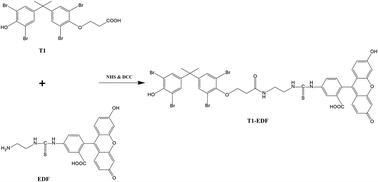A camelid VHH-based fluorescence polarization immunoassay for the detection of tetrabromobisphenol A in water
Abstract
Tetrabromobisphenol A (TBBPA) is a widely used flame retardant and is classified as an endocrine disruptor. A convenient and sensitive fluorescence polarization immunoassay (FPIA) for TBBPA was developed with a camelid variable domain of heavy chain antibody (VHH) being specific for TBBPA. 3-(2,6-Dibromo-4-(2-(3,5-dibromo-4-hydroxyphenyl)propan-2-yl))propanoic acid (hapten T1) was conjugated with ethylenediamine fluorescein thiocarbamoyl (EDF) to form a tracer that binds with anti-TBBPA VHH. The limit of detection and half-maximum inhibition concentration of TBBPA by FPIA were 5 ng mL−1 and 90 ng mL−1, respectively. This FPIA was used to detect TBBPA in water samples without any pre-treatment and each analysis was performed within 20–30 min. The recovery of TBBPA from spiked water samples ranged from 73% to 102%, with coefficients of variation ranging from 7% to 14%. The FPIA exhibited high potential for rapid and accurate determination of TBBPA in real water samples.


 Please wait while we load your content...
Please wait while we load your content...